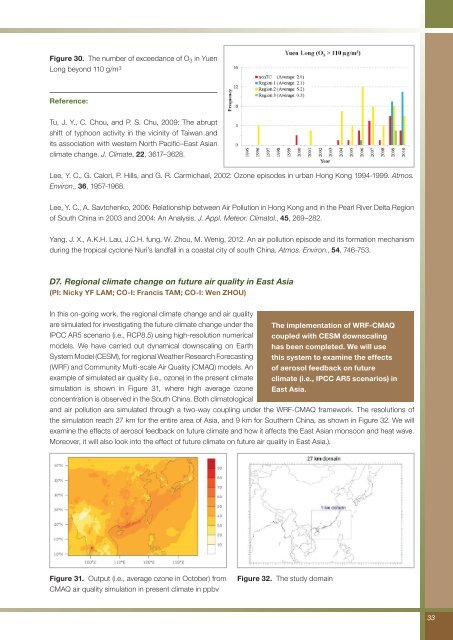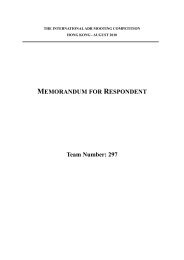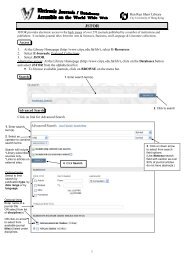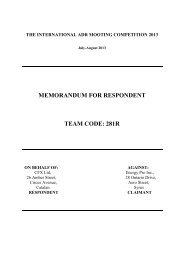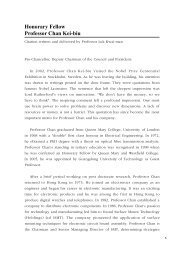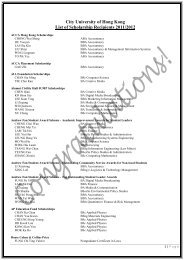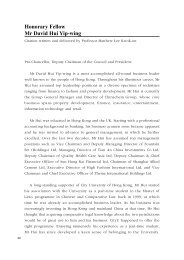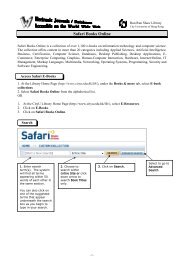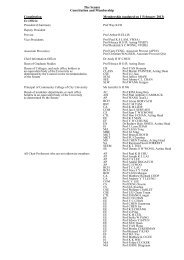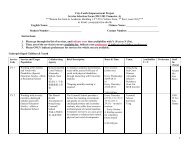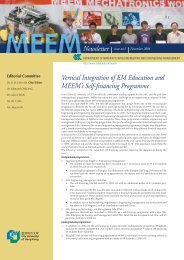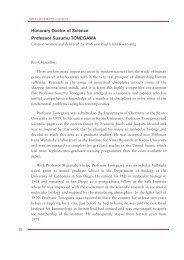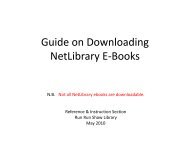Annual Report 2012 - City University of Hong Kong
Annual Report 2012 - City University of Hong Kong
Annual Report 2012 - City University of Hong Kong
You also want an ePaper? Increase the reach of your titles
YUMPU automatically turns print PDFs into web optimized ePapers that Google loves.
Figure 30. The number <strong>of</strong> exceedance <strong>of</strong> O 3 in Yuen<br />
Long beyond 110 g/m 3<br />
Reference:<br />
Tu, J. Y., C. Chou, and P. S. Chu, 2009: The abrupt<br />
shift <strong>of</strong> typhoon activity in the vicinity <strong>of</strong> Taiwan and<br />
its association with western North Pacific–East Asian<br />
climate change. J. Climate, 22, 3617–3628.<br />
Lee, Y. C., G. Calori, P. Hills, and G. R. Carmichael, 2002: Ozone episodes in urban <strong>Hong</strong> <strong>Kong</strong> 1994-1999. Atmos.<br />
Environ., 36, 1957-1968.<br />
Lee, Y. C., A. Savtchenko, 2006: Relationship between Air Pollution in <strong>Hong</strong> <strong>Kong</strong> and in the Pearl River Delta Region<br />
<strong>of</strong> South China in 2003 and 2004: An Analysis. J. Appl. Meteor. Climatol., 45, 269–282.<br />
Yang, J. X., A.K.H. Lau, J.C.H. fung, W. Zhou, M. Wenig, <strong>2012</strong>. An air pollution episode and its formation mechanism<br />
during the tropical cyclone Nuri’s landfall in a coastal city <strong>of</strong> south China. Atmos. Environ., 54, 746-753.<br />
D7. Regional climate change on future air quality in East Asia<br />
(PI: Nicky YF LAM; CO-I: Francis TAM; CO-I: Wen ZHOU)<br />
In this on-going work, the regional climate change and air quality<br />
are simulated for investigating the future climate change under the<br />
IPCC AR5 scenario (i.e., RCP8.5) using high-resolution numerical<br />
models. We have carried out dynamical downscaling on Earth<br />
System Model (CESM), for regional Weather Research Forecasting<br />
(WRF) and Community Multi-scale Air Quality (CMAQ) models. An<br />
example <strong>of</strong> simulated air quality (i.e., ozone) in the present climate<br />
simulation is shown in Figure 31, where high average ozone<br />
concentration is observed in the South China. Both climatological<br />
and air pollution are simulated through a two-way coupling under the WRF-CMAQ framework. The resolutions <strong>of</strong><br />
the simulation reach 27 km for the entire area <strong>of</strong> Asia, and 9 km for Southern China, as shown in Figure 32. We will<br />
examine the effects <strong>of</strong> aerosol feedback on future climate and how it affects the East Asian monsoon and heat wave.<br />
Moreover, it will also look into the effect <strong>of</strong> future climate on future air quality in East Asia.).<br />
Figure 31. Output (i.e., average ozone in October) from<br />
CMAQ air quality simulation in present climate in ppbv<br />
The implementation <strong>of</strong> WRF-CMAQ<br />
coupled with CESM downscaling<br />
has been completed. We will use<br />
this system to examine the effects<br />
<strong>of</strong> aerosol feedback on future<br />
climate (i.e., IPCC AR5 scenarios) in<br />
East Asia.<br />
Figure 32. The study domain<br />
33


